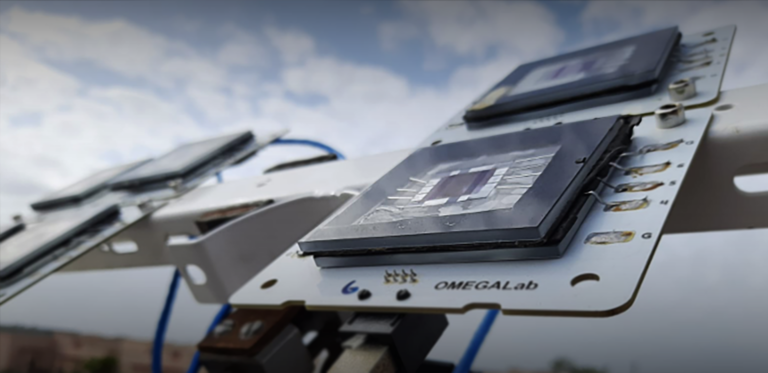Material Science and Engineering
Utilizing a broader share of the solar spectrum
Graphene quantum dots can improve the efficiency of silicon solar cells.


A graphene quantum dot (white) on top of a solar cell formed by silicon (Si) insulating (ITO) and metal (Au) layers.
Reproduced with permission from reference 1. © 2016 American Chemical Society
Small flakes of graphene could expand the usable spectral region of light in silicon solar cells to boost their efficiency, new research from KAUST shows1.
Solar cell materials have become significantly cheaper to produce in recent years, yet further cost savings are needed to make solar technologies commercially attractive. The prevalence of silicon in solar cells makes them a good target for efficiency enhancement.
“By improving the efficiency of silicon solar cells, we can provide a more cost-effective way for energy production,” said Jr-Hau He, Associate Professor of Electrical Engineering, who also led the research team.
Graphene quantum dots are small flakes of graphene that are useful because of their interaction with light. One of these interactions is optical downconversion, which is a process that transforms light of high energies into lower energy (for example, from the ultraviolet to the visible).
Downconversion can be used to boost solar cells. Silicon absorbs light very efficiently in the visible part of the spectrum and therefore appears black. However, the absorption strength of silicon for ultraviolet light is much smaller, meaning that less of this light is absorbed, reducing the efficiency of solar cells in that part of the spectrum. One way to circumvent this problem is the downconversion of ultraviolet light to energies where silicon is a more efficient absorber.
Graphene quantum dots are ideal candidates for this purpose. They are easy to manufacture using readily available materials such as sugar and by then heating them with microwave radiation. While the dots are almost transparent to visible light, which is important to pass that light through to the solar cell, they are efficient in converting UV light to lower energies.
The researchers integrated the quantum dots on a silicon solar cell device. The efficiency of the solar cells increased in comparison to control samples. For a mature technology to show a clear improvement in efficiency is promising because it can be produced using an easy manufacturing process.
The test sample solar cells measured so far have not yet been optimized to be closer to the record-breaking performances seen in silicon. The researchers therefore plan to combine some other enhancement technologies previously achieved in similar devices, He noted.
“We have been successfully utilized surface engineering treatments, including fabricating nanostructures and passivation layers, to improve the light harvesting and the electrical properties of solar cells. By integrating these techniques all together, we hope that in the next few years, the world record can be broken at KAUST,” he said.
References
-
Tsai, M.-L., Tu, W.-C., Tang, L., Wei, T.-C., Wei, W.-R., Lau, S.P., Chen, L.-J. & He, J.-H. Efficiency enhancement of silicon heterojunction solar cells via photon management using graphene quantum dot as downconverters. Nano Letters 16, 309−313 (2016).| article
You might also like

Material Science and Engineering
Electron movie guides design of layered perovskite materials

Material Science and Engineering
Remote region sensor for essential vitamin deficiency

Material Science and Engineering
Low-power hydrogen sensor detects leaks in an instant

Material Science and Engineering
Illuminating pathways to long-lived organic solar cells

Chemistry
Beating the dark current for safer X-ray imaging

Chemical Engineering
Net benefits for advanced materials design

Material Science and Engineering
Atom-thin insulator grown into perfect films

Material Science and Engineering



